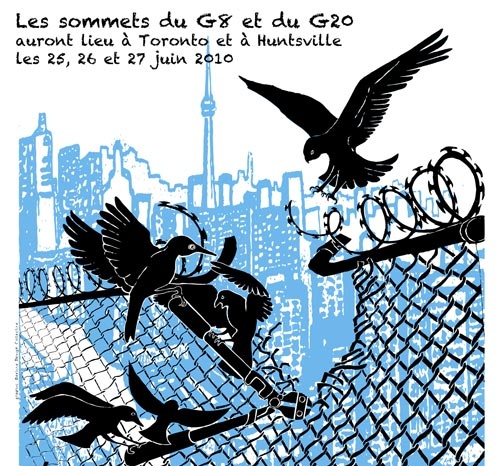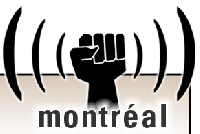 |
 |
 |
 |
 |
 |
|
 |
 |
 |
 |
 |
 |
 |
Régions du Québec |  |
 |
 |
|
 |
 |
|
 |
 |
|
 |
 |
 |
 |
 |
 |
Rubriques (sujets) |  |
 |
 |
|
 |
 |
|
 |
|
 |
 |
 |
Shedding Democracy for Tears
The effects of using tear gas against democratic dissent are medically and politically problematic.
When the meetings and were over at the Summit of the Americas in Quebec City
last April, police had used
canisters of tear gas over a 72 hour period, effectively filling downtown
with gas. A
later, homes and other buildings in downtown were still contaminated by the
gas, and
for a public inquiry had been
dismissed.
Prime Minister Jean Chrétien
congratulated police for "conducting themselves in an exemplary manner",
said their actions were "appropriate", and mentioned their "restraint" while
noting that protestors "had the right to protest but we will not tolerate
breaking the peace of the people...You have the right to speak but you have to
respect the law." Other officials were more cautious, noting that Quebec had
gone better than recent mass protests in Seattle and Washington DC as a
result, or so the implication went, of the police's actions, not the
protesters's.
Chrétien's comments are curious, given that people who intend to do serious
damage would have likely forseen the need for a gas mask. Conversely, being
bombarded with tear gas was a strong impetus for many otherwise peaceful
protesters to throw rocks. The tear gas did as much to break the "peace of the
people" as any action on the part of protesters. Despite repeated condemnations
of a "violent minority", the massive use of tear gas effectively assaulted
thousands of peaceful protesters and peaceful residents. According to
multiple eyewitnesses, medics who were treating tear gas victims were targeted
by police. Additionally, the police raided a temporary, volunteer clinic space
where injured protesters were being treated.
[Police] marched everyone...in the alley (the decontamination
space) out at gunpoint. This included many medics and their patients, even
seriously injured ones. The cops forcibly removed all the protective gear from
everyone, including gas masks, vinegar bandannas and any goggles, saying "No
more protection for you guys!".
They also took all the medical
supplies and equipment that was in the alley or being carried by the medics.
They then marched them, hands in the air and at gunpoint, out into the gas.
They made them walk one way, then changed their minds and marched them another
direction. My friend Sean said that one guy next to him was hit in the head
with a rubber bullet, and the cops wouldn't allow him to stop and treat the
person.
(from
Sara Ahronheim, a volunteer medic during the protests. I heard many identical
firsthand accounts from people who had been in the clinic space when police
drove them out.)
Aside from the
of politicians, the use of tear gas raises some serious health and human rights
issues. The type of gas most often used by police to deter protests is
o-chlorobenzylidenemalononitrile, often called "CS gas" or
just "CS".
CS gas, along with its relatives, CN and CR, consists of crystals which
vaporize at high temperature. Technically, then, it's a spray, not a gas. CS
irritates the skin, eyes and upper respiratory tract, causing severe
discomfort, pain, or, in high concentrations, asphyxiation. Proponents of
continued use of CS note that when "used properly" (i.e. outdoors, in low
concentrations), it is effective in dispersing crowds without causing permanent
damage.
But these conclusions depend on the assumption that people are
otherwise compelled to leave an area contaminated with gas, which is
not always the case with urban protests. In Quebec City, for example, police
fired tear gas canisters into a crowded staircase, where people could not
easily leave. In other cases, passages were blockaded by police, making it easy
to be trapped. Or, as the authors of an EU report mentioned below put it,
"operational usage sometimes means individuals face additional punishment or
even death if they seek to leave a contaminated zone." But forcing individuals
to leave the "contaminated zone" is often precisely the point of deploying CS
in the first place.
A
medical studies reveals that
- CS is both clastogenic and mutagenic;
- severe injury from exploding tear gas canisters is possible and has been documented;
- CS has caused lethal toxic injury in documented cases.
A European Union report on crowd control technologies (available
excerpted here) goes
into greater detail, noting that extended exposure to CS can cause, in ordinary
terms, "victims to die by drowning in their own lung fluids" and "
simply, exposure to CS even in low concentrations raises blood pressure, which
can be a serious risk to people over 30 or those with heart conditions. CS is
especially harmful to infants, of which there were many in the populated
downtown area of Quebec. Outside of medical studies, protesters who've been
exposed to CS have reported weakened immune systems for months after exposure,
and women have experienced premature menstruation within hours of exposure.
CS is not the only substance delivered by tear gas canisters.
ketone (MIBK), is used as a solvent for CS, which is normally in crystal
form. MIBK has a number of
effects, including headaches, vomiting, and dizziness. It has not been
established whether MIBK is carcinogenic.
Asphyxiating gasses like CS are prohibited for military use by the 1925
Geneva
chemical weapons. But you wouldn't know it given Chrétien's smug comments
and the lack of concern shown by other governments which use CS. Indeed, the
British and American governments asserted after signing the protocol
that CS was not covered because it's "not harmful to man". CS was allowed for
specific applications, such as dispersing rioting prisoners of war, later on,
but it remains banned for offensive use.
Gassing citizens, whether peacefully protesting or simply because they
happen to live in the wrong place at the wrong time, is apparently a different
matter altogether. Further, in war it's generally understood that medics and
downed victims are not to be targeted; indeed, the
both. Medics and tear gas victims were intentionally gassed in Quebec.
Dispersing a crowd might be within legally accepted uses of CS, but using it as
an offensive weapon against passive crowds, peaceful protesters, medics, and
injured people is not. Or so one might hope.
The clear message sent by police actions in Quebec, then, is that even the
most basic standards of conflict can be set aside when dealing with domestic
protests. That governments feel compelled to be more civil in war than in
confrontations with their own citizens is a grave sentiment indeed. Not only
does it escalate the mistreatment of protesters, which, by most
indications, is being consolidated in Genoa, but has real health
consequences, both for humans and for democracy.
 |
 |
 |
 |
Dossier G20 |  |
 |
 |
|
 |
 |
|
 |
Nous vous offrons plusieurs reportages indépendants et témoignages...

Liste des activités lors de ce « contre-sommet » à Toronto Vous pouvez aussi visiter ces médias alternatifs anglophones... Centre des médias Alternatifs Toronto 2010.mediacoop.net Media Co-op Toronto http://toronto.mediacoop.ca Toronto Community Mobilization www.attacktheroots.net (en Anglais) |
 |
 |
 |
 |
 |
 |
 |
CMAQ: Vie associative |  |
 |
 |
|
 |
 |
|
 |
 Collectif à Québec: n'existe plus. Impliquez-vous ! |
 |
 |
 |
 |
 |
 |
 |
 |
|
 |
 |
 |
Ceci est un média alternatif de publication ouverte. Le collectif CMAQ, qui gère la validation des contributions sur le Indymedia-Québec, n'endosse aucunement les propos et ne juge pas de la véracité des informations. Ce sont les commentaires des Internautes, comme vous, qui servent à évaluer la qualité de l'information. Nous avons néanmoins une
Politique éditoriale
, qui essentiellement demande que les contributions portent sur une question d'émancipation et ne proviennent pas de médias commerciaux.
This is an alternative media using open publishing. The CMAQ collective, who validates the posts submitted on the Indymedia-Quebec, does not endorse in any way the opinions and statements and does not judge if the information is correct or true. The quality of the information is evaluated by the comments from Internet surfers, like yourself. We nonetheless have an
Editorial Policy
, which essentially requires that posts be related to questions of emancipation and does not come from a commercial media.


